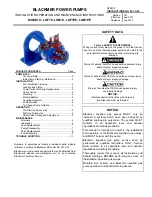
12
ENGLISH
Required space approx. 100 mm
diameter.
The pump must not be submerged
deeper into water then stated in the
"Technical Specifications".
The pump' suction inlet must not be
positioned in the well's filtration area
and not near the bottom. Position
the pump as high as possible in the
well, but at least 2 m below the
water level.
In case the pump is not operated in
a tube well the operator must ensure
that no foreign matter is taken in.
A
Caution!
Do not lift pump at cable or dis-
charge hose; both are not designed
for the tensile load by the weight of
the pump.
1. Lower pump to the bottom of the
fluid container. Use a sturdy rope
fastened to the pump head to lower
the pump.
The pump can also be operated
when suspended by a rope.
2. Plug the power cable in.
6.1
Switching ON and OFF
To start the submersible pump plug
the power cable in.
Unplug to stop the pump.
A
Caution!
At too low a water level the
deep well pump runs dry and will be
damaged or destroyed.
When operating the pump always
make sure that the water level is suffi-
cient and dry running is not possible.
Damage caused by running dry is not
covered by the manufacturer's war-
ranty!
Overload protection
This submersible pump has an overload
protection which automatically turns the
motor off in case the pump is over-
loaded.
If the overload protection has tripped:
1. Unplug.
2. Remove cause for the overload (see
"Care and Maintenance").
6.2
Pump Characteristic
Curve
The pump characteristic curve shows
which pump capacity is possible in
dependance on the delivery head.
A
Danger!
Prior to all servicing:
1.
Turn OFF.
2.
Unplug.
3.
Ensure that pressure is relieved
from the pump and connected
accessories.
Service and repair work other than
described here must be left to quali-
fied specialists.
7.1
Periodic Maintenance
In order for the deep well pump to func-
tion perfectly at any time periodic main-
tenance is required. This also applies if
the deep well pump is operated under
heavy conditions, but not turned on over
prolonged periods.
Let the pump run periodically to
keep solids from getting stuck inside
the pump.
Leave pump in the water if possible,
to keep residual matter from drying
inside the pump.
Yearly maintenance
1. Check pump casing and cable for
damage.
2. Rinse pump with clear water.
Remove persistant soiling, e.g.
algae desposits, with brush and
dishwashing liquid.
3. To flush the inside of the pump,
place it into a container filled with
clear water and turn ON briefly.
Cleaning the suction inlets
1. At the bottom of the lower part, in
the centre opening, is a locking for
removing the end piece.
Unscrew the three securing screws
from the locking.
2. Push all three plastic locking bars of
the locking from inside to the outside
and pull the end piece out.
3. Clean end piece with clear water
and fit it back into the pump. The
plastic locking bars must engage
with an audible click.
Cleaning the impellers
1. Loosen the screws on the upper part
of the deep weel pump and remove
the top.
3
Note:
If necessary you can remove the
power cable. To do so, loosen the two
screws of the cable clamp and pull off
the cable plug.
2. Completely unscrew the lower part.
3. Unscrew the hexagon nut on the
impeller shaft and pull the impellers
off.
4. Clean impellers and all accessible
inside surfaces of the casing.
Remove any fibres which may have
wound around the impeller shaft.
Remove persistant soiling with
brush and dishwashing liquid.
A
Caution!
When reassembling the pump
make sure the O-rings on both upper
and lower part are undamaged and
properly positioned.
5. Re-assemble the deep well pump.
7.2
Pump Storage
A
Caution!
Frost damages the pump and
accessories, as both always contain
water!
When there is danger of freezing
remove pump and accessories and
store in a frost-free location.
A
Danger!
Prior to all servicing:
1.
Turn OFF.
2.
Unplug.
3.
Ensure that pressure is relieved
from the pump and connected
accessories.
8.1
Troubleshooting Guide
Pump does not run:
No mains voltage.
Check cables, plug, outlet and
mains fuse.
Mains voltage too low.
Use only extension cables with
sufficient lead cross section (see
"Technical Specifications").
6.
Operation
7.
Care and Maintenance
8.
Troubleshooting
Содержание TBP 5000 M
Страница 37: ...37 1 1 2 3 4 5 22 m 15 m 1 2 3 4 5 TBP 4000 M TBP 5000 M XP0028G5 fm...
Страница 39: ...39 DIN VDE 0100 702 A A 5 B 30 mA A A...
Страница 40: ...40 10 bar 100 C 5 1 6 5 2 A 100 mm 2 m A 1 2 6 1 A 1 2 6 2 A 1 2 3 5 6 6 7...
Страница 41: ...41 7 1 1 2 3 1 2 3 1 3 2 3 4 A 5 7 2 A A 1 2 3 8 1 A Metabo Metabo www metabo com www metabo com 100 8 9 10...
Страница 48: ...48 1 1 2 3 4 5 TBP 4000 M TBP 5000 M 1 2 3 4 5 22 15 XP0028RU5 fm...
Страница 50: ...50 DIN VDE 0100 702 A A 5 B 30 A...
Страница 51: ...51 A 10 100 C 5 1 6 5 2 A 100 2 A 1 2 6 1 A 1 2 6 2 5 6 6...
Страница 52: ...52 A 1 2 3 7 1 1 2 3 1 2 3 1 3 2 3 4 A 5 7 2 A A 1 2 3 8 1 A Metabo Metabo www metabo com www metabo com 7 8 9...
Страница 55: ......
Страница 56: ...Metabowerke GmbH Metabo Allee 1 72622 Nuertingen Germany www metabo com...













































